LESSON 3.7
Create the Old Section
Grades 1-3
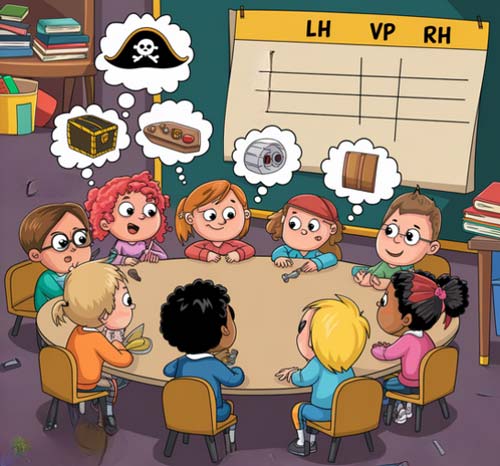
Remember how you created the hero in the story about the talking dog? You broke it down into:
- Talking + dog
Then you decided your hero could be:
- I + talking
Or
- I + dog
For example:
- Maybe your hero had trouble talking or was scared of public speaking.
Then—
| WHAT STATEMENT | ||
|---|---|---|
| LH | VP | RH |
| Hero | VP | Troublemaker |
| I + talking | because | talking dog |
Or maybe the hero had a problem with a dog. Maybe it ran away or died.

| WHAT STATEMENT | ||
|---|---|---|
| LH | VP | RH |
| Hero | Verb Phrase | Troublemaker |
| I + dog | had a problem with | a talking dog |
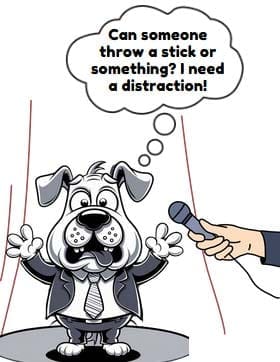
Move Part of Troublemaker to the Hero
Here is what the story of the tiny man of mirrors looks like so far:
| LH | VP | RH |
| Hero | Verb Phrase | Troublemaker |
| I | had a problem with | a tiny man of mirrors I found in a buried treasure chest |
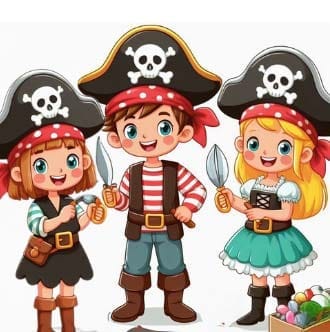
- Pirates
- Treasure
- Being small
- Mirrors
- Finding things
You are the hero. Maybe you love playing pirate, or you and your sisters once made pirate costumes.
Then your chart could look like this:

| LH | VP | RH |
| Hero | Verb Phrase | Troublemaker |
| I + pirates | had a problem with | a tiny man of mirrors I found in a buried treasure chest |
Or maybe you are good at finding things. Then you move “finding “things” to the LH.

| LH | VP | RH |
| Hero | Verb Phrase | Troublemaker |
| I + finding things | had a problem with | a tiny man of mirrors I found in a buried treasure chest |
Task 3.7.1 – Class
Move ONE part of the troublemaker to the hero’s box.
Introduce the Old Section
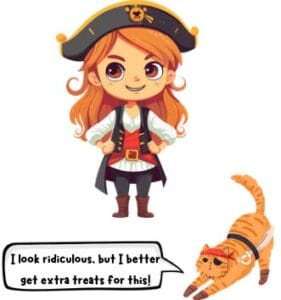
To create the first sentence, just say how you feel about what you moved from the troublemaker. Keep it short. Examples:
- “I have always wanted to be a pirate.”
- “I like pirates.”
- “I am good at finding things.”
- “I like finding things.”
By a show of hands, pick the first sentence you like best.
Task 3.7.2 – Class
Create a first sentence.
Task 3.7.3 – Small Groups
Tell things related to the first sentence. Your teacher will write them down on the board. Here’s an example:
Teacher: Your first sentence is I like finding things. So now let’s begin to discuss that. Discuss means to explain. How about My friends call me Metal. Why might your friends call you “Metal”?
Student 1: ‘cause I like heavy metal. (Everyone laughs.)
Teacher: Why else?
Student 2: because we like finding things that are metal?
Teacher: Good! And what do people use to find metal things?
Student 3: I know! I know! My dad has one. A metal detector.
Teacher: That’s great! What kind of things can you find with a metal detector?
Student 3: Metal things?
Example
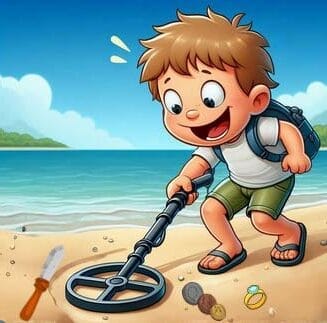
Teacher: Yes, but what metal things?
Student 4: Rings?
Teacher: What else?
Student 5: Watches?
Student 6: Coins?
Teacher: Have you found anything really cool?
Student 3: I found a Bowie knife. It was beautiful
Teacher: Did you keep it?
Student 3: I gave it to my dad for Christmas. (Everyone laughs and applauds.)
Write Sentences
Turn your ideas into sentences. Your teacher will help. Don’t worry about spelling or grammar. You might end up with something like this:
“I like finding things. My friends call me Metal because I like heavy metal and using my dad’s metal detector. I find cool stuff like watches, rings, and coins. Once, I found a beautiful knife on the beach and gave it to my dad for Christmas.”
Task 3.7.4 – Tandem

- I like finding things. (2) My friends call me Metal. (3) Because I like heavy metal. (4) And because I like to mess around with my dad’s metal detector. (5) I use it to find really cool stuff. (6) Like watches, rings, and coins. (7) Once I found a beautiful knife at the beach. (8) I gave it to my dad for Christmas.
